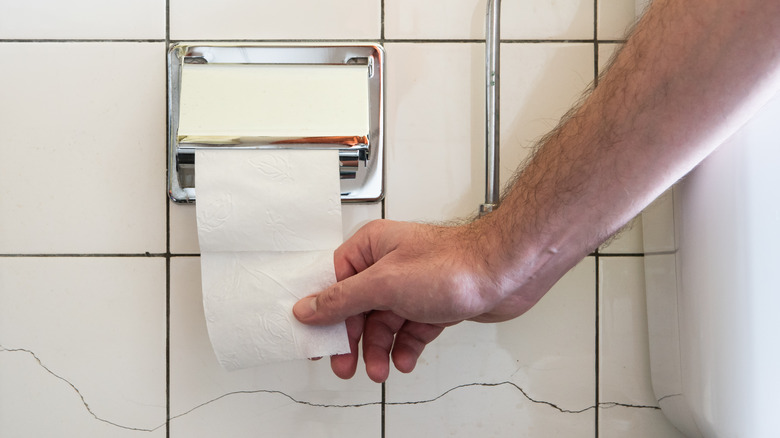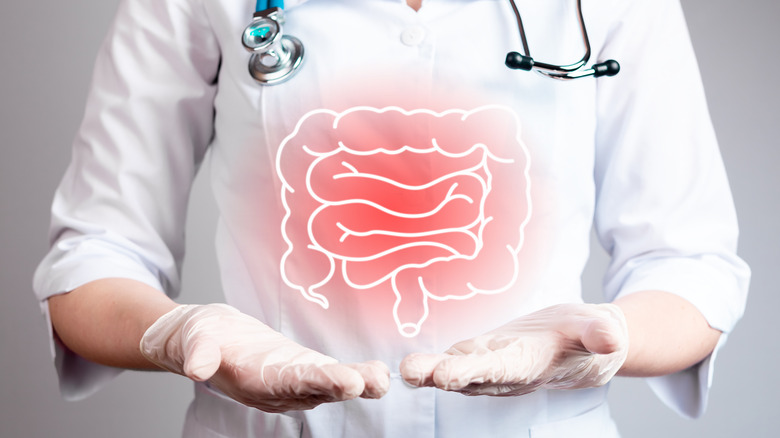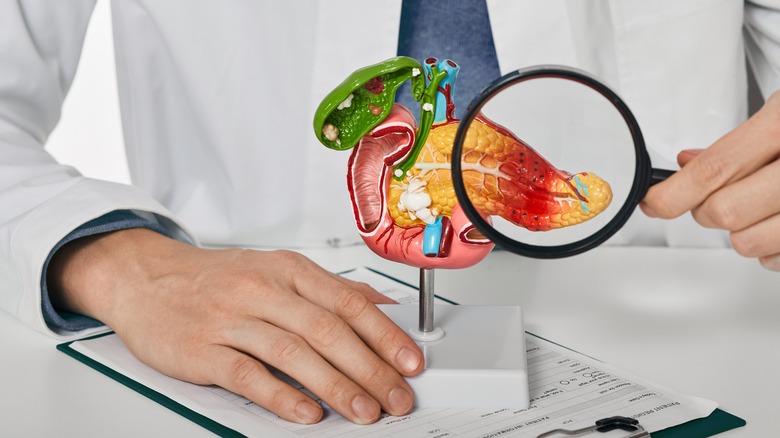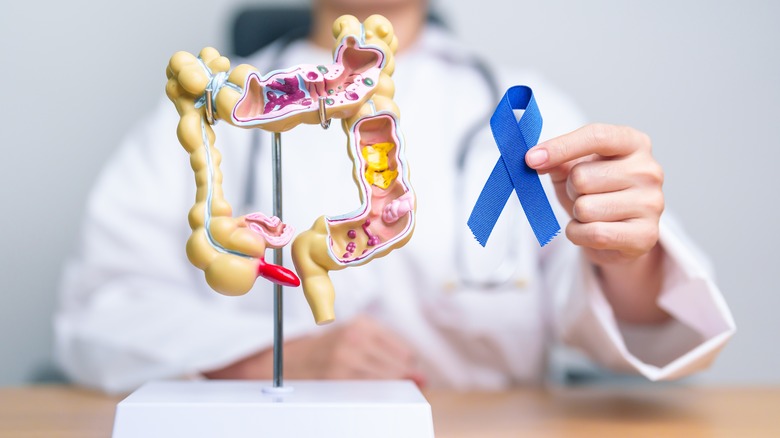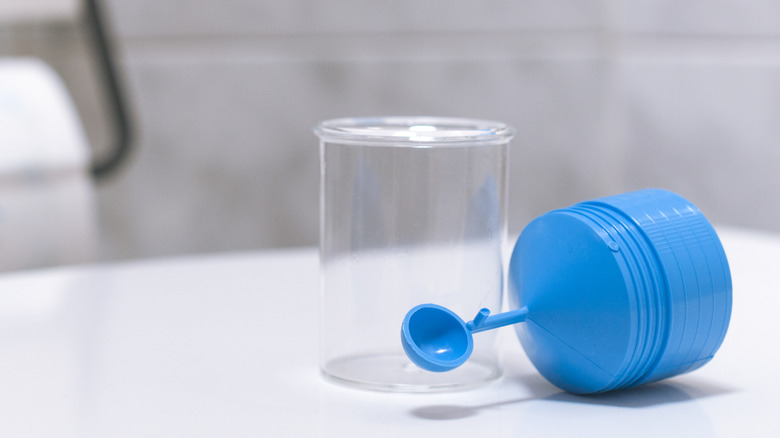Medical Diagnoses That Require Swabbing Your Own Poop
When it comes to medical diagnostics, perhaps one of the most unconventional yet indispensable procedures involves the collection and analysis of fecal matter — yes, that's right, your own poop. Despite what you might think, stool tests play a crucial role in detecting various gastrointestinal (GI) disorders and providing valuable insights into overall health. These tests are utilized for a wide range of purposes, going from screening for colorectal cancer to assessing digestive function and uncovering underlying health conditions (via the Cleveland Clinic).
According to a study published in Turkish Archives of Pediatrics, a stool test involves the careful collection and examination of poop to gather details or indicators of diseases that affect the GI tract. Per the study, stool samples are tested for hidden blood, fats, sugars, acidity, and enzymes, among others, as well as infectious microorganisms such as bacteria, viruses, and parasites. Additionally, the testing process includes a visual inspection of stool for characteristics including color, consistency, volume, shape, odor, and mucus. By carefully examining poop samples, these different stool tests help doctors understand gut health better and figure out the best treatments for each person in a non-invasive way. In some cases, they may even save you from going through unnecessary lab tests. Keep reading to find out which medical conditions can be diagnosed by taking a closer look at your poop.
Inflammatory bowel diseases
Crohn's disease and ulcerative colitis are both inflammatory bowel diseases (IBD), which are conditions that, by causing constantly recurring inflammation of different parts of the digestive tract, can lead to GI-related symptoms like bloody or loose stools, abdominal pain, tiredness, and weight loss (via Healthline). In both cases, stool tests play a crucial role in diagnosis by providing valuable insights into the presence and severity of inflammation in the intestines.
One such test is the calprotectin stool test, which measures inflammation levels in the GI tract. According to Medical News Today, elevated levels of the protein calprotectin can indicate inflammation, which is often associated with IBD. Per the site, the test is also helpful for monitoring Crohn's disease and ulcerative colitis by helping determine the efficacy of their treatment. However, while stool tests like calprotectin provide essential information, they are not enough on their own to diagnose an IBD (per InflammatoryBowelDisease.net). Instead, they should be used alongside other testing methods, like physical examinations, blood tests, and other diagnostic procedures like endoscopy. These complementary methods help doctors confirm the presence of IBD and determine its extent and severity.
Exocrine pancreatic insufficiency
Exocrine pancreatic insufficiency (EPI), a condition where the pancreas fails to produce enough digestive enzymes (those that help break down food), is often the result of various pancreatic disorders, including chronic pancreatitis, cystic fibrosis, pancreatic cancer, and certain gastrointestinal diseases such as IBD or celiac disease (via the National Institute of Diabetes and Digestive and Kidney Diseases (NIDDK)). Due to the lack of digestive enzymes, people with EPI often struggle to adequately digest food and absorb nutrients, resulting in consequences like malnutrition, deficiencies in fat-soluble vitamins (A, D, E, and K), low bone density, growth impairments in children, weakened immune function, and heightened risk of heart attack and stroke.
Per the NIDDK, healthcare providers typically rely on a combination of stool tests, blood tests, and, occasionally, pancreatic function tests to diagnose EPI. According to a study published in Clinical and Experimental Gastroenterology, the stool elastase test, also known as fecal elastase-1 or FE-1 test, is the most commonly used indirect test for EPI diagnosis. As an indirect test, it measures levels of elastase, a pancreatic enzyme, in stool samples in a non-invasive and less expensive way. Per the study, in normal conditions, fecal elastase levels are five times higher than in the pancreatic juices. Thus, low concentrations of elastase in stool indicate a positive EPI diagnosis. However, to ensure accurate results, providing a solid or semisolid stool sample for the test is crucial, as liquid stool can lead to false-positive outcomes.
Colon cancer
Colon cancer is a form of cancer where cells in the colon grow uncontrollably. While it is often asymptomatic in its early stages, colon cancer can lead to symptoms such as changes in bowel habits, blood in or on the stool, diarrhea, constipation, abdominal discomfort, and unexplained weight loss, per the Centers for Disease Control and Prevention (CDC). Various screening tests are available to detect colon cancer early and improve its outcome, including fecal occult blood tests (FOBT) and stool DNA tests.
As its name suggests, the FOBT screens stool samples for hidden blood, indicating potential bleeding within the GI tract (via the Mayo Clinic). Your doctor can choose from several different FOBTs. Options include the immunochemical fecal occult blood test (iFOBT or FIT), the guaiac fecal occult blood test (gFOBT), or the disposable reagent pad. However, the site explains that while the FOBT can identify the presence or absence of blood, it cannot pinpoint the exact source of bleeding. On the other hand, a stool DNA test analyzes stool samples for genetic changes that reveal the presence of cancerous cells in the colon. It can also detect hidden blood (per the Mayo Clinic). A positive result from either test may prompt further screening tests, such as a colonoscopy, to confirm the presence of the cancer and determine the appropriate intervention.
Gastrointestinal infections
GI infections caused by harmful bacteria, parasites, or viruses can lead to a range of symptoms, including diarrhea, dysentery (stools with blood and mucus), abdominal pain, nausea, vomiting, and fever. Thus, according to an article published in the Journal of Gastrointestinal Infections, testing your stool for harmful microorganisms or germs is key in diagnosing these infections.
Various stool tests are available to detect GI infections, including the GI pathogen panel, stool cultures, and the ova and parasite (O&P) exam (via Testing). The GI pathogen panel, in particular, uses advanced methods to find genetic material from common microbes that cause GI infections. It can detect multiple disease-causing microorganisms at once and find germs that stool cultures and O&P exams might miss. Per the article, while most stool tests require minimal preparation, you may need to refrain from using certain products, such as laxatives or antibiotics, before collecting a sample. It's essential to collect a fresh stool sample in a clean container to avoid contamination and promptly deliver it to the laboratory no longer than two hours after collection.
Bleeding in the digestive tract
GI bleeding happens when there's blood loss from any part of your digestive system, which goes from the esophagus and stomach all the way down to the small intestine, colon, rectum, and anus (via the Cleveland Clinic). Detecting blood in stool is vital for detecting GI bleeding, and even more so is noting the color of the blood, as it can indicate where the bleeding is coming from. Typically, the darker the blood, the farther up the origin of the bleeding. For example, according to WebMD, bright-red blood normally suggests bleeding in the lower part of the GI tract (colon, rectum, or anus). In contrast, dark red or brown blood may indicate bleeding higher up in the colon or small intestine. Lastly, black, tarry stools, known as melena, often signify bleeding in the stomach.
Numerous conditions can cause GI bleeding, ranging from cancers and ulcers to inflammatory disorders. To diagnose the cause of GI bleeding, doctors may order various tests based on your symptoms. Among these diagnostic tools is a stool test, which, per WebMD, can detect clotting problems, anemia, and infections such as H. pylori. Stool tests play a crucial role in identifying GI bleeding and guiding healthcare providers in determining the appropriate treatment plan for the underlying condition.
Steatorrhea
Steatorrhea, also known as fatty poop, is what happens when your body struggles to break down and absorb fats. According to the National Library of Medicine (NLM), it is one of the most common malabsorption syndromes. Moreover, due to the complex mechanism that takes place in the metabolism of fats, steatorrhea can derive from problems in your small intestine, pancreas, liver, or bile ducts since they all play a role in digesting this nutrient (via the Cleveland Clinic). Having steatorrhea can make your stools pale, bulky, and stinky, and they might even float, making them a pain to flush down the toilet. Initially, steatorrhea may not cause noticeable symptoms, but in severe cases, it can lead to visible signs like loss of subcutaneous fat and muscle tissue and deficiencies in fat-soluble vitamins (A, D, E, and K), via NLM.
Per the site, to figure out if you're dealing with steatorrhea, doctors often use a stool test called the 72-hour fecal fat excretion test to measure the amount of fat excreted. This stool test involves collecting your poop for three consecutive days after having followed a strict diet containing 100 grams of fats per day for five days. By conducting this test, healthcare providers can pinpoint the cause of steatorrhea and tailor treatment accordingly, aiming to improve fat absorption and alleviate associated symptoms.
Lactose intolerance
Lactose intolerance appears from a deficiency in lactase, the enzyme responsible for breaking down lactose in dairy products into glucose and galactose. Per the NLM, this condition affects about 65% of the global population, and it is more common among African Americans, Hispanics/Latinos, and Asians while less common in people of European descent. A lactase deficiency leads to unabsorbed lactose within the bowel, triggering an influx of water into the intestine, which results in diarrhea. Besides loose stools, other symptoms of lactose intolerance include abdominal bloating, pain, nausea, flatulence, and borborygmi (stomach rumbling).
Diagnosing lactose intolerance may involve stool tests, particularly the stool acidity test, which is commonly used for infants and very young children (per MediciNet). The test works because the presence of unabsorbed lactose is fermented by bacteria in your gut into lactic acid, causing a decrease in stool pH and making it more acidic. Thus, this acidity serves as an indicator of lactose intolerance. Another diagnostic test is the lactose hydrogen breath test, which measures the amount of hydrogen in the breath after consuming a lactose solution. However, this one is more commonly employed in adults and older children, seeing that it may lead to diarrhea-induced dehydration in a younger population.
Parasitic infections
Parasites are living organisms that live and feed off another living organism (aka host, like a person or an animal). Parasitic infections are caused by three main types of organisms: protozoa, helminths (worms), and ectoparasites, all of which cause different kinds of illnesses (via Healthline). According to WebMD, a healthcare provider may suggest getting a parasite test when presenting symptoms of a parasite infection, such as diarrhea, bloating, nausea, abdominal pain, fatty stools or steatorrhea, weight loss, gas, dehydration, fever, or an itchy rectum.
Per the CDC, multiple tests can help diagnose parasitic diseases, depending on your symptoms, medical history, and travel history. One standard test is the stool ova and parasite (O&P) test, which checks for parasites and their eggs in your stool. This test is particularly useful for identifying parasites that cause abdominal issues like diarrhea, cramps, and flatulence. To improve the likelihood of finding any parasites, the site recommends testing three or more stool samples collected on separate days. A positive result means you have an infection, and your doctor will be able to provide appropriate treatment to help you recover.
How to collect a stool sample
Collecting a stool sample is very easy, but in some cases, it might require some preparation beforehand. If your healthcare provider tells you so or your test instructions specify it, avoid using laxatives, synthetic fat substitutes like Olestra, and fat-blocking nutritional supplements for the 72 hours leading up to and during the collection period. Additionally, if you've recently had a barium enema (which is used to check for problems in the colon), wait at least 48 hours before starting the collection, as barium can interfere with the test results (per the Mayo Clinic Laboratories).
Typically, a stool collection kit will include two screw-capped containers and a plastic holder to attach to the toilet, making the collection process significantly easier. To collect a sample, lift the toilet seat, set the plastic holder across the toilet bowl rim, remove the cap from one of the containers and place it in the holder, and lower the toilet seat. After a bowel movement, remove the container and place the lid firmly on top until you hear a click. You could store the sealed container in the refrigerator to avoid any lingering poop smells, which won't affect the test results. Moreover, the site explains that you should collect additional samples if you have multiple bowel movements during your stool collection period, which could range from 24 to 72 hours. Following these steps ensures a proper and uncontaminated stool sample for accurate testing.
